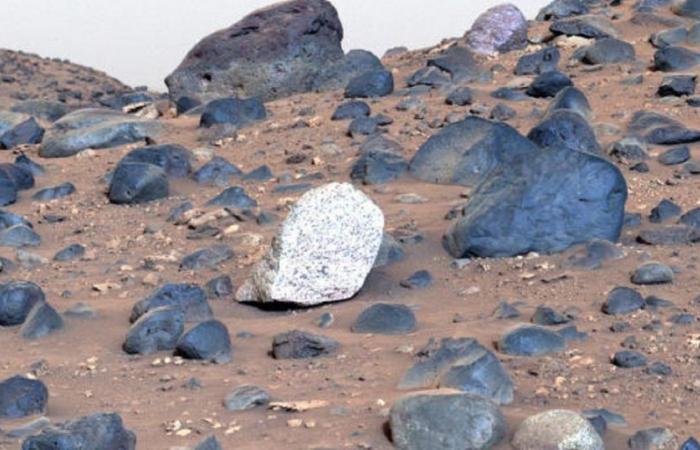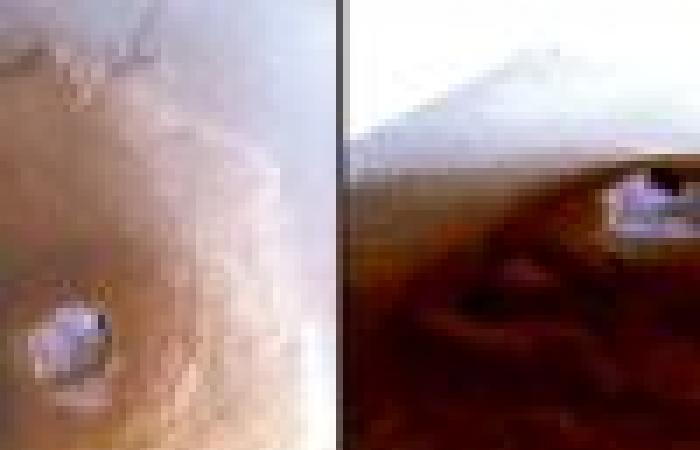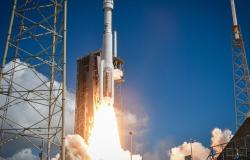⇧ [VIDÉO] You might also like this partner content
In the midst of its fourth “campaign” to Mars, while exploring Jezero Crater, NASA’s Perseverance rover made an unprecedented discovery: a light-toned rock that visually stands out from the dark rocks nearby. This is the first object of this type observed on the Red Planet, according to mission researchers. This discovery could well reveal new information about the geology of Mars.
The Perseverance rover landed on Mars in 2019 with the aim of probing the ancient Jezero crater. As the craft crossed the Neretva Vallis (a region believed to contain traces of an ancient dried-up river that flowed into the crater billions of years ago), mission engineers made it change course, because the terrain was too rough. So, he took “a shortcut” through a dune field before reaching a hill called “Mount Washburn.”
Images captured by the rover as it traveled on its new trajectory show that the hill is covered in boulders, some of which were described as belonging to “a type never before observed on Mars,” according to a NASA statement. A rock measuring approximately 45 cm wide and 35 cm high particularly attracted attention, with its light tones which set it apart from the others.
An invitation to dream, ready to be worn.
“The diversity of textures and compositions of Mount Washburn was an exciting discovery for the team, as these rocks represent a bag of geological goodies descended from the crater rim and potentially beyond said Brad Garczynski of Western Washington University, who co-led the last Perseverance mission. “ But among all these different rocks, there is one that really caught our attention “, he added.
An anorthosite rock?
Garczynski and his team dubbed the mysterious rock “Atoko Point.” Through extensive analysis of the rock with the rover’s instruments, they discovered that it is made up of pyroxenes and feldspars (groups of minerals). According to the US Geological Survey and NASA, these two groups of minerals are also present in the Earth’s crust. Some members of the Perseverance team have hypothesized that Atoko Point could come from an underground source of Martian magma before being exposed on the edge of the Jezero over time following erosion.
However, the composition of the rock is vastly different from its surroundings. This is why other scientists on the team suspect that it might have come from another part of the Red Planet and was transported to its current location by the Neretva Vallis Current.
See as well
Katie Stack Morgan, deputy project scientist for the Mars 2020 mission, thinks this discovery could be even more accomplished than NASA initially let on. The composition of the rock suggests that it is likely anorthosite, a type of rock previously unobserved on Mars. “ Seeing a rock like Atoko Point is one of those clues that, yes, we have anorthosites on Mars, and this could be a sample of this lower crustal material ” Morgan said.
It was in the Martian region called the “Margin Unit” that the Rover discovered Atoko Point, while searching for deposits containing carbonate and olivine. These two groups of minerals have already been observed by Perseverance and are of interest to scientists because of their ability to encapsulate certain geological remains. Identifying the carbonate in the Martian crater could theoretically allow researchers to identify traces of ancient life on the planet, potentially preserved in the mineral. As for olivine, scientists are currently analyzing it to try to understand when the Martian climate may have become conducive to the presence of organic compounds such as running water and potentially life.
“ If we see anorthosite late in the context of other rocks, it may give us an idea of how the first crust of Mars arose “, explains Morgan. Either way, the existence of Atoko Point means that there are certainly other rocks of this type somewhere else on the Red Planet. Currently, the rover is evaluating whether it is worth collecting a rock core in the Margin Unit area for later analysis, NASA says.







